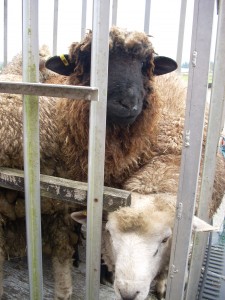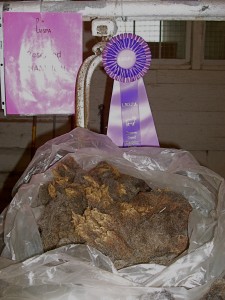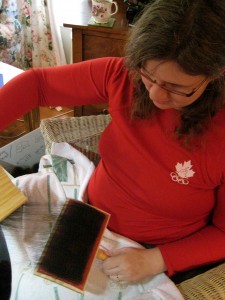Recently the Fall programs began here at the studio. The knitters are working through the steps to build a fair isle yoked, steeked cardigan. The spinners requested a project based program, and are now living the consequences of that decision. We are throwing around the P words a lot. Process and patience represent the reality of the way we create yarn and garments (and runner beans, as it turns out). . . . slowly! We dream of the product, but try not to go there at these early stages.


In September, we met for our first spinning class, to prepare for, and then attend, the Lower Mainland Sheep Producers Annual Fleece sale on the Belmont Farms in Langley. The students learned what to look for in a healthy, quality fleece. There were 88 to choose from, ranging from long wools, down breeds, primitive breeds, and interesting cross breeds. Three of us chose beautiful Icelandic lamb fleeces raised by Loretta Tennant in Greendale near Chilliwack. The sales were made by silent auction, so we bid on the fleeces we loved, and were lucky to get them.
These fleeces were really clean, and only took two washings to prepare for carding. Icelandic sheep are a primitive double-coated breed, introduced to Iceland by the Vikings more than a 1000 years ago. The outer coat, tog, is hair-like, longer, and similar to mohair. The inner coat, thel, is soft and wooly, with crimp. Sheared from a lamb, these two coats may both be soft, and can be processed together. Sheared from an older sheep, the difference between the two coats can be quite significant, and they may need to be processed separately. We have decided to work ours as one. This requires careful teasing and carding, and attentive spinning as we draft, so that the shorter fibres do not clump up in the yarn. Spun well, the tog will support the thel, and provide the air space that will allow the thel to bloom into an airy yarn when washed.
One student purchased an 11 lb. Romney fleece, and has chosen to flick card it, and spin it in the grease, right off the sheep. Cardigan thinks that’s a great idea, and is sticking close to supervise! This spinner has processed enough yarn to work up a sample, and is knitting to establish the gauge for her project; a bulky lap blanket for her husband.
My beautiful icelandic fleece is almost black, and I have chosen to work it into a project with a chartreuse mohair/wool roving that I purchased from Hannelore Luben, and some blue-faced leicester that I dyed in the exhaust bath left from the beginner’s spinning program in the summer. I can visualize the project, but will probably change my mind a few times before that happens!
Working slowly with natural fibres allows for many magical moments. Creating a beautiful workspace, filled with tunes and tea, is a good first step. The studio is comfortable and well-equipped with an extensive fibre arts library. On those days when the process is just too overwhelming, and patience may be waning, there is always something to inspire.













